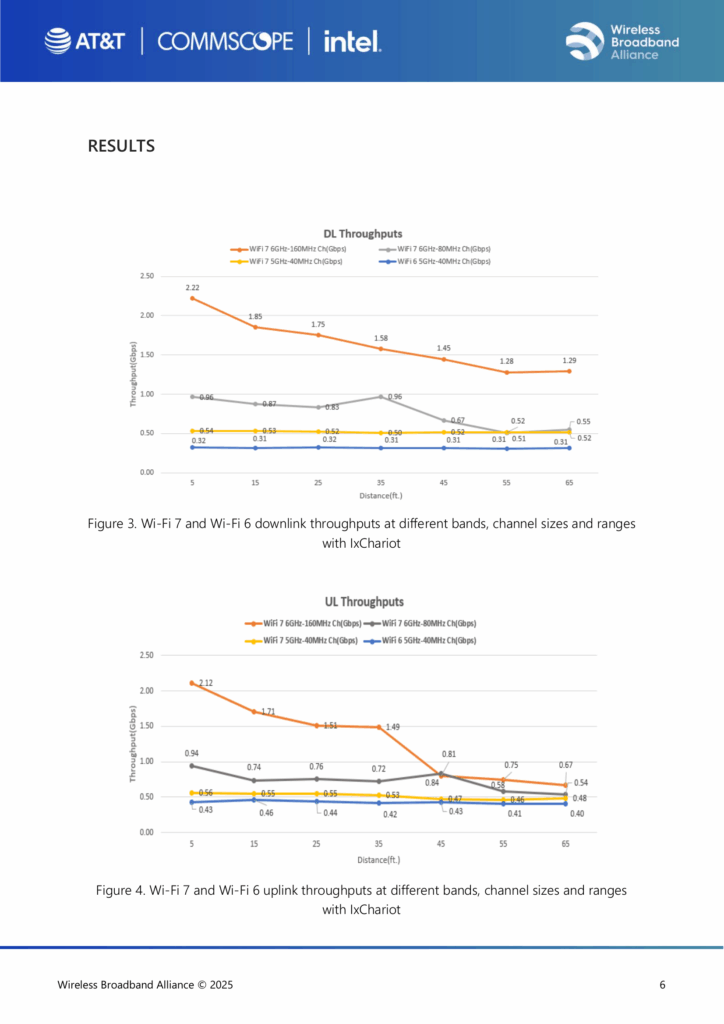WBA, AT&T, Intel and CommScope highlight real-world gains in speed, reliability and efficiency as Wi-Fi 7 sets the stage for next-gen enterprise connectivity
The Wireless Broadband Alliance (WBA), in partnership with AT&T, CommScope (RUCKUS Networks) and Intel, has released new findings from real-world enterprise trials of Wi-Fi 7, showing major performance improvements over previous Wi-Fi generations. Conducted in a live enterprise environment, the trials mark a significant step forward in validating Wi-Fi 7’s readiness to support demanding business applications including immersive XR, cloud computing, AI-driven automation and industrial IoT.
Key results from the multi-phase initiative showed Wi-Fi 7 delivering:
- Nearly double the throughput of Wi-Fi 6E at 5 GHz using 40 MHz channels
- Sustained 1 Gbps+ throughput at 40 feet using 160 MHz channels on the 6 GHz band
- 2 Gbps downlink speeds at close range
- Improved latency and reliability in high-density environments through Multi-Link Operation (MLO)
“Wi-Fi 7 is not just an evolution, it’s a game changer for enterprise connectivity,” ,” said Tiago Rodrigues, CEO of the WBA. “These trials prove that Wi-Fi 7 offers real-world improvements in speed, reliability, and efficiency that businesses need to support the next generation of applications. As adoption accelerates, enterprises will see tangible benefits in everything from hybrid work and immersive experiences to AI-driven automation.”

Real-world setup, real results
Testing was conducted in an AT&T office setting, using standard access points and client devices, with no performance tuning to skew results. Seven test locations, ranging from 5 to 65 feet from the access point, were evaluated to measure throughput, latency and signal strength.
Hardware included CommScope’s RUCKUS R770 Wi-Fi 7 access points and Intel BE200 Wi-Fi 7 chipsets, with comparisons made using Wi-Fi 6 and 6E gear on the same laptops. Tests used a combination of Ixia IxChariot, Windows file transfers and ping/jitter measurements to assess performance across 5 GHz and 6 GHz frequencies.
Performance boost at all distances
Wi-Fi 7 showed dramatic uplink and downlink performance gains. At 6 GHz using 160 MHz channels, Wi-Fi 7 reached 1.9 Gbps downlink and 2.1 Gbps uplink speeds at 5 feet. Importantly, it sustained over 1 Gbps throughput up to 40 feet, a range typically seen in dense enterprise deployments.
In the 5 GHz band using 40 MHz channels, Wi-Fi 7 nearly doubled the performance of Wi-Fi 6 — achieving 0.55 Gbps downlink vs. 0.25 Gbps and 0.58 Gbps uplink vs. 0.31 Gbps. This showcases notable gains even in legacy spectrum, a major benefit for enterprises with mixed-device environments.
“These trials confirm that Wi-Fi 7 can deliver the high-performance, low-latency connectivity required for modern digital environments,” said JR Wilson, VP of tower strategy & roaming at AT&T. He added that the carrier sees Wi-Fi 7 as a “key enabler” for enterprises that want to optimize their operations.
Multi-Link Operation and 4K QAM
One standout feature of Wi-Fi 7 is Multi-Link Operation (MLO), which enables devices to transmit and receive across multiple channels or bands simultaneously, drastically improving efficiency and resilience in congested environments. Another is 4K QAM, which boosts peak data rates by up to 20% compared to Wi-Fi 6’s 1K QAM.
The trials also noted improved performance in high-density deployments — crucial for environments like offices, hospitals, factories and event venues where thousands of devices compete for bandwidth.
“Wi-Fi 7 introduces groundbreaking features that significantly enhance throughput and efficiency,” said Mittal Parekh, Senior Director at RUCKUS Networks. “This technology is ready to meet the most demanding enterprise applications.”
Looking ahead — enterprise rollout and standard power boost
The trials used Low Power Indoor (LPI) mode, which limits transmit power to meet regulatory guidelines. Future tests will explore Standard Power Wi-Fi 7, enabled through Automated Frequency Coordination (AFC), which could double signal range and further boost reliability, particularly in large indoor or campus environments. AFC is currently operational and authorized in the United States and Canada, while several other countries including are evaluating its feasibility.
The WBA’s roadmap includes further assessments of MLO, Quality of Service (QoS) and network-wide performance as more Wi-Fi 7 equipment reaches the market. The group’s next-phase testing will help guide deployment best practices and ensure smooth transitions for enterprises upgrading from Wi-Fi 6 or 6E.
With organizations facing growing demands from cloud-based workflows, real-time video and next-gen apps, Wi-Fi 7’s increased bandwidth and reduced latency come at a critical time. The ability to deliver consistent multi-gigabit performance across both new and legacy spectrum positions Wi-Fi 7 as a cornerstone of enterprise digital infrastructure.
“6 GHz Wi-Fi 7 marks a major leap forward in wireless technology,” said Eric McLaughlin, VP at Intel. “With improved spectrum utilization and dramatic performance improvements, the findings of the trial help underscore Wi-Fi 7’s ability to meet the needs of next-gen applications in enterprise, industrial and residential settings.”

